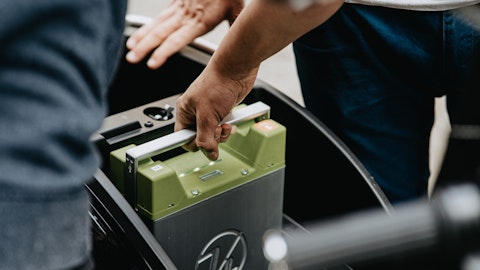Vincent Andrews: Okay. And then, Eric, if I could ask you on the Chinese converters or the non-integrated converters, kind of referenced this earlier that at current spodumene prices, some of them are backing off. At least on our calculations, spodumene prices could still go down quite substantially and most spodumene producers would still be quite profitable. So, is there a reason why that won’t happen that those spodumene producers won’t – just lower price to keep their customers operating so that they can make sales and generate cash, or is there something in that market dynamic that’s not obvious to me?
Eric Norris: Well, I mean I think in theory, you are right. I mean there is margin to give from a spodumene mine producer. But then on the other hand, there is market demand, what’s required. That’s the counter effect to price, obviously. And with the amount of capacity that will come off, while the room for spodumene prices to potentially come down at some point, there is now demand for salts in the market that is not being met, and that would turn things the other way around, right. So, it’s about the demand equation, which I think generally speaking, the market is to soft, not the trade, not the lithium market. But the broader global markets, stock markets are a little down on is that the demand is not as weak, we see it as weak as being portrayed and particularly in China.
So, as that – and in China, as a reminder, is about 70% of the world’s consumption or production of EVs. So, I think it’s the demand factor that would be the mitigating factor on further spodumene prices. But to your point, I don’t know we know exactly where spodumene prices will go because we keep – it’s hard to predict relative to when there is a stimulus on demand that pulls them back up.
Vincent Andrews: Okay. Thanks very much. I appreciate it and congratulations, Scott, on retirement. I appreciate all your help over the years.
Scott Tozier: Thanks Vincent.
Operator: Your next question comes from Colin with Oppenheimer. Colin, your line is open.
Colin Rusch: Thanks so much guys. With the inventory hanging out at these lower levels, we are seeing some new balances in terms of a variety of supply chains. What’s your expectation around where that normalizes in terms of days of inventory? It seems like the industry is running awfully lean at this point. And then if you could also address what you are hearing from some of your longer term OEM customers around concerns on security supply as they adjust some of their EV production plans?
Eric Norris: So, Colin, it’s Eric. On your first question, I don’t know that we have a good answer for that. It’s because it’s perpetually operated, particularly if you look at Chinese cathode producers at levels which are less than a week, this is – contrast that with our supply chain and this inventory lag that is one of the most popular and understandably popular question being asked today, the reason we have that is it takes six months to go from mine to product on our side. And if there is any disruption in the supply chain, five days of supply at a cathode producer is not going to be enough. So, it doesn’t feel sustainable, but they have been able to operate that way throughout the year. So, there are some question marks we would have about what’s a sustainable and responsible way as a company to operate your supply chain for security purposes.
And I just I got to believe that it’s got to be higher downstream at some point than it is, but I don’t think we know exactly what it could be. And then in terms of the global OEM sort of concern on security supply, there is no letup from OEMs on interest and long-term off-takes in securing supply. Yes, it is true. There are some OEMs who have announced some changes to their or expressed some concerns about their targets. But I think if you look at the larger players in the EV space, keeping in mind that, that isn’t necessarily the companies that are now announcing that they are pushing out their targets. Those larger producers are going to continue to increase their output whether they are here or in China or in Europe and they are continuing to demand security and supply because they realize they cannot fulfill the large investments they are making downstream in electric vehicles without lithium.
So, I think that demand – that dynamic is still there with the OEMs.
Operator: Our final question comes from the line of Steven [ph] with Bank of America. Steven, your line is open.
Unidentified Analyst: I just wanted to ask you whether you would be looking at any new technologies to extract more lithium out of the brand deposits in Argentina, anything that you are – you think could bolster your production there at a more capital-efficient way in any of these technologies in development that you see could potentially lower the reinvestment economics?
Kent Masters: Yes. So, we – I mean look, we have a broad R&D program and extracting lithium and converting lithium to salt and other materials is the big part of that. From the program, it sounds like you are referencing would be around direct lithium extraction, which is a variety of technologies. It’s not just one particular thing, but a variety of technologies that tends to be unique for each brine. And we have a program around that, that’s – it’s kind of broad in nature, but it’s very focused on the resource we have in Magnolia and the Salar de Atacama. It would also apply in Argentina as well or to any brine resources. But what – at the moment, the work is particularly focused on the Salar de Atacama and the brine to Magnolia, Arkansas.
Unidentified Analyst: Very good. Thank you.
Operator: That was all the time we have for questions. I would like to turn the call back over to Kent.
Kent Masters: Okay. Thank you. Thank you all for joining us today, and I apologize for the technical difficulties. I think we have got the line on the speaker side muted for a period of time. I apologize for that. Albemarle leads the world in transforming essential resources into the critical ingredients for modern living with people and planted in mind. We are confident in the market opportunity and our disciplined strategy to achieve both short-term and long-term results. We continue to work to be the partner of choice for our customers and the investment of choice for both the present and the future. Thank you for joining us today.
Operator: Ladies and gentlemen, that concludes today’s conference call. Thank you for your participation. You may now disconnect.
Follow Albemarle Corp (NYSE:ALB)
Follow Albemarle Corp (NYSE:ALB)
Receive real-time insider trading and news alerts





